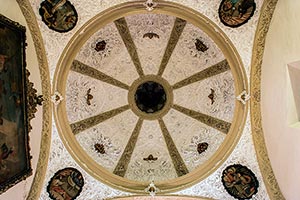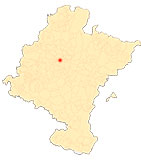Basilica of St. Ignatius of Loyola
By Ricardo Fernández Gracia
|
|
|
|
|
|
|
|
|
|
|
|
|
|
|
|
|
|
|
|
|
|
|
|
|
|
|
|
|
|
|
|
|
|
|
Eighteenth-century reform
Little time elapsed between the inauguration and the decoration of the interior. The explanation was none other than the triumph of the traditional baroque style in such significant works in the city, such as the chapel of San Fermín or the altarpieces of the Recoletas. From agreement with the development of the style in its decorative phase, the vaults were covered with rich plasterwork, with vegetal bouquets, made around 1720. The pendentives with four scenes from the life of the saint and the medallion with the moment of the fall completed the ensemble. The cost of those works was 210 reales (mason), 1,249 (carver), 176 (lumps), 458 (painter), 770 (colors), 108 (whitewasher) and 75 (scaffolding).
Along with the plastic plasterwork that imitate plants, the four pendentives and another oval with the fall of the saint in the center of the frontal arch stand out. In those are represented passages or scenes from the life of St. Ignatius. In the first one we find the appearance of St. Peter with his two crossed keys and St. Ignatius who is in his bed with his leg bandaged and wounded. The second sample the apparition of the Virgin and Child, in Loyola in 1521, in harmony with the text of his autobiography which reads: "Being awake one night he clearly saw an image of Our Lady with the Holy Child Jesus, with the sight of which, for a period of B, he received very excessive consolation". The third one sample shows the saint with the cassock, writing the Exercises in 1522, under the protection of Mary. The last one presents him keeping vigil in Montserrat (March 24-25, 1522), also following the autobiographical text that says: "After going to confession and giving his clothes and wearing the tunic of a pilgrim, he goes to visit on foot and prostrates himself before the Virgin of Montserrat".
In keeping with that decorative and colorful display was the feast of the fall of the saint, magnificently endowed, in 1754, by the Duke of Granada de Ega and Count of Javier, Don Antonio de Idiáquez, with a sung mass, sermon, music and feast. The account books record payments for music, butter, blancmange, veal pies and dozens of rockets. Regarding the feast, it should be remembered that it was frequent in the great celebrations that, during two or three hours of the afternoon, until the evening performance, the musicians would show off their skills, improvising and playing music board member and instrumental music.
file Diocesan of Pamplona. Government of the Diocese. administrative office de Cámara. Boxes 293, 294, 295, 296 and 297.
ASCUNCE, E., Íñigo de Loyola, capitán español, y el castillo de Pamplona, Madrid, Aguado, 1939.
AZANZA LÓPEZ, J., La arquitectura religiosa del Barroco en Navarra, Pamplona, Government of Navarre, 1998.
EGUILLOR, J. R., Loyola, historia y arquitectura, San Sebastián, Etor, 1991.
FERNÁNDEZ GRACIA, R., El retablo barroco en Navarra, Pamplona, Government of Navarre, 2003.
FERNÁNDEZ GRACIA, R., "The Jesuits in Pamplona 1580-1767". Diario de Navarra, 28 April 2014, pp. 70-71.
FERNÁNDEZ GRACIA, R., "Heritage and identity (52). The basilica of San Ignacio in Pamplona". Diario de Navarra, 21 May 2021, pp. 62-63.
GARCÍA GAÍNZA, M.ª C. et al., Catalog Monumental de Navarra V. Merindad de Pamplona ***, Pamplona, Institución Príncipe de Viana, 1997.














